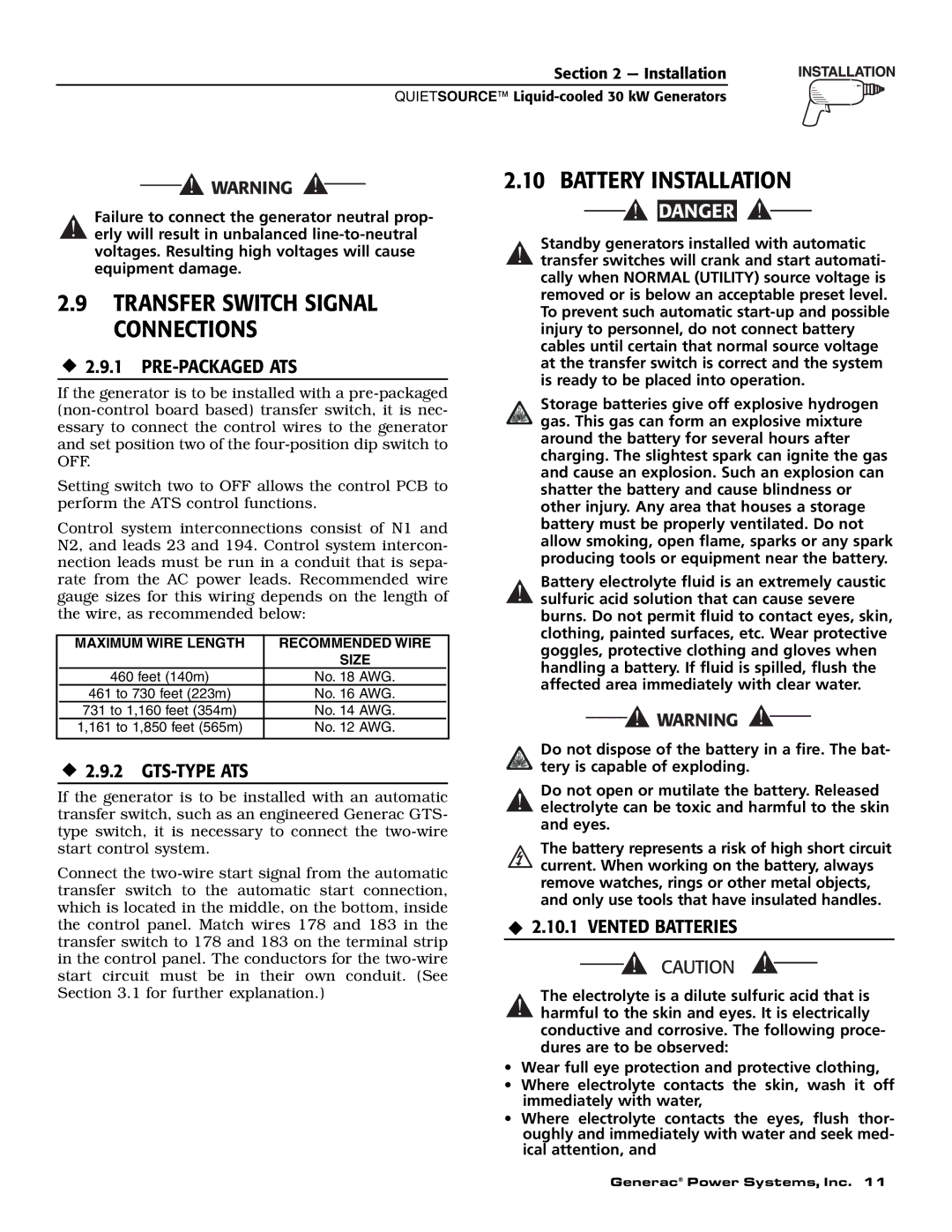
Section 2 — Installation
QUIETSOURCE™
Failure to connect the generator neutral prop-
!erly will result in unbalanced
2.9TRANSFER SWITCH SIGNAL CONNECTIONS
2.9.1 PRE-PACKAGED ATS
If the generator is to be installed with a
Setting switch two to OFF allows the control PCB to perform the ATS control functions.
Control system interconnections consist of N1 and N2, and leads 23 and 194. Control system intercon- nection leads must be run in a conduit that is sepa- rate from the AC power leads. Recommended wire gauge sizes for this wiring depends on the length of the wire, as recommended below:
| MAXIMUM WIRE LENGTH | RECOMMENDED WIRE |
|
|
| SIZE |
|
| 460 feet (140m) | No. 18 AWG. |
|
| 461 to 730 feet (223m) | No. 16 AWG. |
|
| 731 to 1,160 feet (354m) | No. 14 AWG. |
|
| 1,161 to 1,850 feet (565m) | No. 12 AWG. |
|
|
|
|
|
2.10BATTERY INSTALLATION
![]()
![]() DANGER
DANGER ![]()
Standby generators installed with automatic ! transfer switches will crank and start automati-
cally when NORMAL (UTILITY) source voltage is removed or is below an acceptable preset level. To prevent such automatic
Storage batteries give off explosive hydrogen gas. This gas can form an explosive mixture around the battery for several hours after charging. The slightest spark can ignite the gas and cause an explosion. Such an explosion can shatter the battery and cause blindness or other injury. Any area that houses a storage battery must be properly ventilated. Do not allow smoking, open flame, sparks or any spark producing tools or equipment near the battery.
Battery electrolyte fluid is an extremely caustic ! sulfuric acid solution that can cause severe
burns. Do not permit fluid to contact eyes, skin, clothing, painted surfaces, etc. Wear protective goggles, protective clothing and gloves when handling a battery. If fluid is spilled, flush the affected area immediately with clear water.
2.9.2 GTS-TYPE ATS
If the generator is to be installed with an automatic transfer switch, such as an engineered Generac GTS- type switch, it is necessary to connect the
Connect the
Do not dispose of the battery in a fire. The bat- tery is capable of exploding.
Do not open or mutilate the battery. Released ! electrolyte can be toxic and harmful to the skin
and eyes.
The battery represents a risk of high short circuit current. When working on the battery, always remove watches, rings or other metal objects, and only use tools that have insulated handles.
2.10.1 VENTED BATTERIES
The electrolyte is a dilute sulfuric acid that is
!harmful to the skin and eyes. It is electrically conductive and corrosive. The following proce- dures are to be observed:
•Wear full eye protection and protective clothing,
•Where electrolyte contacts the skin, wash it off immediately with water,
•Where electrolyte contacts the eyes, flush thor- oughly and immediately with water and seek med- ical attention, and
Generac® Power Systems, Inc. 11
